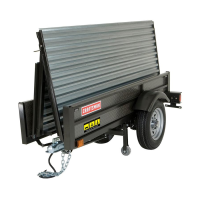24
6.1 Determining Correct Load Limit – Trailer
6.1.1 Trailers 10,000 Pounds GVWR or Less
1. Locate the statement, “The weight of cargo should never exceed XXX kg or
XXX lb.,” on your vehicle’s placard.
2. This gure equals the available amount of cargo and luggage load capacity.
3. Determine the combined weight of luggage and cargo being loaded on the
vehicle. That weight may not safely exceed the available cargo and luggage load
capacity.
The trailer’s placard refers to the Tire Information Placard attached adjacent to or
near the trailer’s VIN (Certication) label at the left front of the trailer.
6.2 Determining Correct Load Limit – Tow Vehicle
1. Locate the statement, “The combined weight of occupants and cargo should
never exceed XXX lb.,” on your vehicle’s placard.
2. Determine the combined weight of the driver and passengers who will be riding
in your vehicle.
3. Subtract the combined weight of the driver and passengers from XXX kilograms
or XXX pounds.
4. The resulting gure equals the available amount of cargo and luggage capacity.
For example, if the “XXX” amount equals 1400 lb. and there will be ve 150 lb.
passengers in your vehicle, the amount of available cargo and luggage capacity is
650 lb. (1400-750 (5 x 150) = 650 lb.).
5. Determine the combined weight of luggage and cargo being loaded on the
vehicle. That weight may not safely exceed the available cargo and luggage capacity
calculated in Step # 4.
6. If your vehicle will be towing a trailer, load from your trailer will be transferred
to your vehicle. Consult the tow vehicle’s manual to determine how this weight
transfer reduces the available cargo and luggage capacity of your vehicle.
6.3 Glossary of Tire Terminology
Accessory weight: The combined weight (in excess of those standard items which
may be replaced) of automatic transmission, power steering, power brakes, power
windows, power seats, radio and heater, to the extent that these items are available
as factory-installed equipment (whether installed or not).
Bead: The part of the tire that is made of steel wires, wrapped or reinforced by ply
cords and that is shaped to t the rim.
Bead separation: This is the breakdown of the bond between components in the
bead.
Bias ply tire: A pneumatic tire in which the ply cords that extend to the beads are
laid at alternate angles substantially less than 90 degrees to the center line of the
tread.
SECTION 6: TIRE & SAFETY
INFORMATION
CHECKING & CHANGING TIRES

